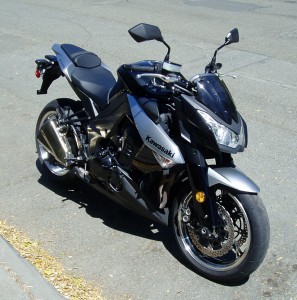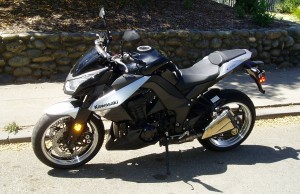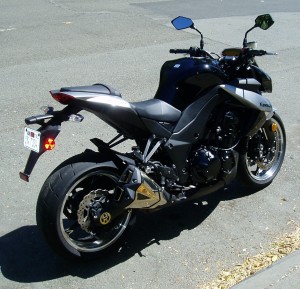All-new and way better
My very first track day took place at Infineon Raceway (I still think of it as Sears Point Raceway) in Sonoma California. It was actually a Keith Code Superbike School that took place on a Monday, following a weekend of Kawasaki sponsored AMA Superbike racing. The school bikes were Kawasaki Ninja 6Rs, which were not at all ideal for my physique ? my elbows were into my knees, and safe, proficient maneuvering was next to impossible. After a couple of attempts at riding the diminutive Ninja, my instructor agreed with me and concluded that the bike was indeed to small for me to ride with any degree of finesse, and opted to allocate a Kawasaki Z1000 as my school steed. Just great I thought ? ?it?s taller, has a 400cc larger displacement, is thereby more powerful and faster?. There was to be no extreme leaning or knee dragging for this rider.

As it turned out, the Z1000?s riding position was considerably more comfortable, and as a result, the bike was much more manageable, and I was able to make it through the day?s exercises without incident and unscathed. The Z1000 was a great bike then, but it?s even better today.
The 2010 Kawasaki Z1000 is all-new ? it is the latest in a long line of ?naked? Kawasaki street bikes. Old rules and engineering were tossed out and the latest iteration Z1000 actually began with a clean sheet of paper, drawing upon more than 35 years of delivering good looking, great performing sport bikes.
Previous Z1000s utilized a steel frame, while the new bike employs an all-new aluminum frame that?s similar in concept to that of the Ninja? ZX?-10R sportbike. The frame beams curve over the engine, resulting in a narrower bike that?s easy to grip with one?s knees, and the engine bolts in solidly at three places, and in a rubber mount at the upper rear of the crankcase as a stressed-member for improved torsional rigidity and solid handling. The main frame and swingarm pivot areas are cast as a single unit, and the rear subframe is a three-piece aluminum, light, smooth die-casting.?
There is an attractive, racy new front cowl that slopes back at a sharp angle , highlighting the newly styled nose, which is followed by a tilting instrument panel with an orange lens that may be angled to suit the rider. Just below that a long, narrow headlight represents Kawasaki?s first use of a line-beam unit. Following?the lines rearward, the eyes will next encounter an artfully sculpted, 4 gallon steel gas tank, with flared sides to fit one?s knees, and trim at the rear for a snug fit. The seat is low and narrow at the front, with a 32.1-inch height making for easy ground contact, and it flows beautifully rearward, ending in a futuristically retro LED taillight behind a red lens.?
Serving as the heart of this new naked Kawasaki is the engine. The engine is a ??1043cc four-stroke, liquid-cooled, DOHC, 16-valve inline-four cylinder with Direct FueI Injection through four 38mm Keihin throttle bodies, with oval sub-throttles.
It gears power through a six-speed sequential manual transmission, routed to the rear wheel via an X-Ring chain final drive. The exhaust is a carry-over of the quad-pipe theme (a 4-into-2-pre-chamber-into-2 layout), with silencer end-caps maintaining the quad-style image from the last Z1000 (and the first Z1), but with an under-engine pre-chamber that allows the use of shorter mufflers for improved appearance, better mass centralization for light, quick handling. A solid-mount handlebar and aluminum footpegs lifted from the Ninja ZX-10R complete with machined edges contribute to the Z1000?s direct feel.?
The Z1000 rides on Dunlop Sportmaxx tires – D210 J 120/70 ZR17 M/C 56W up front, and D210 190/50 ZR17 M/C 175W in the rear, mounted on 5-spoke alloy wheels. Suspension componentry consists of 41mm inverted cartridge forks with stepless compression and rebound damping, adjustable spring preload with 4.7-inches of wheel travel in front and a horizontal monoshock with stepless rebound damping, adjustable spring preload and 5.4-inches of wheel travel aft, delivering UNI-TRAK?-like performance.
Bringing the Z1000 to a halt are hydraulic dual 300mm petal-type rotors with radial- mount 4-piston calipers in front, and a single 250mm petal-type rotor with a single-piston caliper out back.?
Dimensionally, the Z1000 is relatively compact, with a 56.7-inch wheelbase, an overall length of 82.5-inches, a height of 42.1-inches., and the curb weight is 481pounds.
The Z1000 is available in two color schemes: Pearl Stardust white metallic and Metallic Spark Black. My test bike was finished in the latter scheme, and came with a base price of $10,499. Dealer prep and handling can add approximately from $100 to $200.?
SUMMARY: As already indicated, the 2011 Z1000 Kawasaki represents a vast improvement over its predecessors, and the earlier versions were nothing to?sneeze at. The new four-cylinder motor delivers instantaneous gratification when twisting the throttle, across a broad and smooth torque range. Gear changes are precise and the bike?s balance is exceptional. The ride quality is compliant and seemingly just right ? not too firm and not too soft, and if the ride isn?t to your liking, both the front and rear suspension is adjustable.
The riding position is more upright than most sportbikes with pegs and controls positioned just aft of the bike?s center. Passenger pegs even have luggage hooks for conveniently securing personal gear. The handlebars feature a width similar to off-road bikes for greater control, and they are rigid mounted.?
The Z1000 is wicked fast and fun to ride ? not necessarily for the faint of heart or inexperienced rider, but it can be docile as well if need be. The instrument panel with its multifunction LCD display covers all systems, but the orange cover can be highly reflective and difficult to read in bright sunlight with shades on, unless angled just right.?
There are less expensive naked sportbikes, and there are more expensive models as well, but the Z1000 is a striking, visually appealing ride that represents an excellent value, and it also comes with a 12-month warranty.
?











